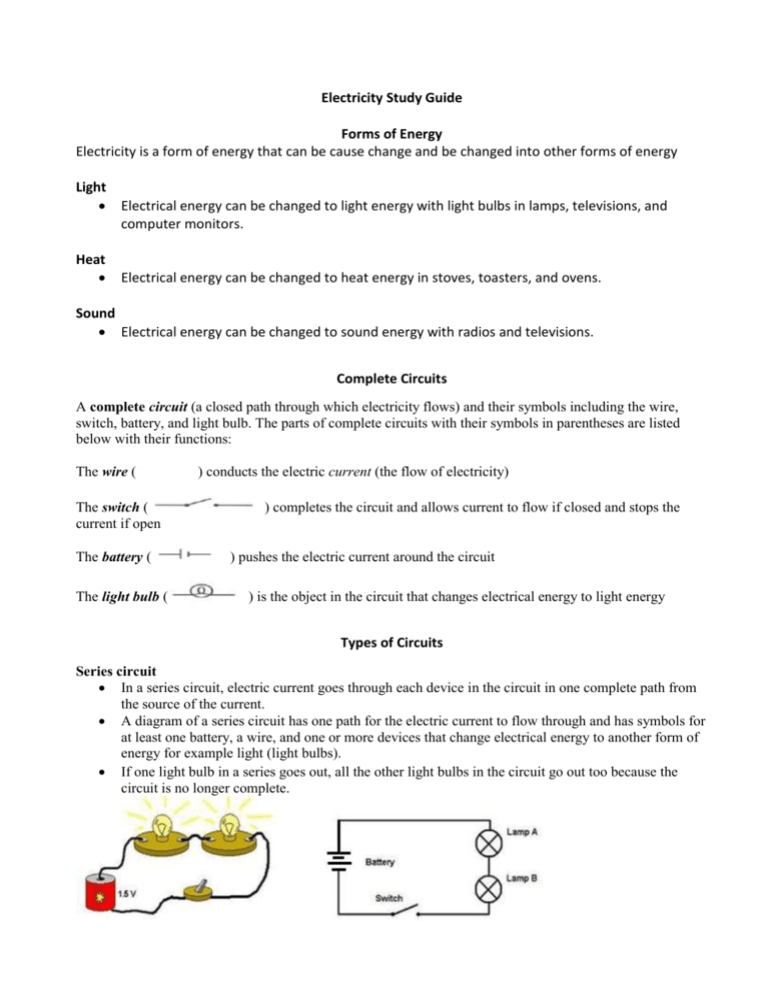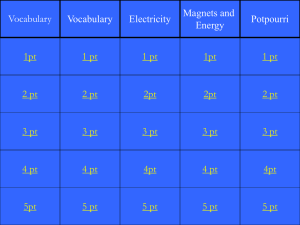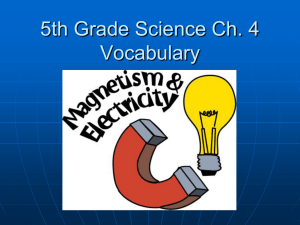Electricity Study Guide Forms of Energy Electricity is a form of
advertisement

Electricity Study Guide Forms of Energy Electricity is a form of energy that can be cause change and be changed into other forms of energy Light Electrical energy can be changed to light energy with light bulbs in lamps, televisions, and computer monitors. Heat Electrical energy can be changed to heat energy in stoves, toasters, and ovens. Sound Electrical energy can be changed to sound energy with radios and televisions. Complete Circuits A complete circuit (a closed path through which electricity flows) and their symbols including the wire, switch, battery, and light bulb. The parts of complete circuits with their symbols in parentheses are listed below with their functions: The wire ( The switch ( current if open The battery ( The light bulb ( ) conducts the electric current (the flow of electricity) ) completes the circuit and allows current to flow if closed and stops the ) pushes the electric current around the circuit ) is the object in the circuit that changes electrical energy to light energy Types of Circuits Series circuit In a series circuit, electric current goes through each device in the circuit in one complete path from the source of the current. A diagram of a series circuit has one path for the electric current to flow through and has symbols for at least one battery, a wire, and one or more devices that change electrical energy to another form of energy for example light (light bulbs). If one light bulb in a series goes out, all the other light bulbs in the circuit go out too because the circuit is no longer complete. Parallel circuit In a parallel circuit, however, the current branches into several loops and has more than one path through which the electric current flows. A diagram of a parallel circuit shows more than one path through which the electric current flows and has symbols for at least one battery and several wires in more than one loop, branch, or path. Each path contains at least one device (for example a light bulb) that changes electrical energy to another form of energy. If a light bulb goes out in one of the loops or paths of a parallel circuit, the lights in the other loops stay on because the electric current can flow in more than one path. Conductors and Insulators Conductors Conductors allow electric current to flow through them in an electric circuit. If a bulb stays lit when an object is added to an electric circuit, the material is conducting the current through the circuit, and it is a conductor. Metals are conductors of electricity. Insulators Insulators do not allow electric current to flow through them in an electric circuit. If a bulb does not stay lit when an object is added to an electric circuit, the material does not conduct current, and it is an insulator. Plastics and wooden materials are examples of insulators. Magnets Polarity Magnets and electromagnets have areas on their ends (if bar or horseshoe magnets) or on their tops and bottoms (if ceramic, plastic, or “donut” magnets) that are called poles. The magnetic pull or attraction is strongest at these poles. Every magnet has a North pole and a South pole. The poles of magnets affect each other in the following ways: Like poles If the North pole of one magnet and the North pole of another magnet are brought close to each other, they will move away from each other or repel. The same thing happens if the South pole of one magnet and the South pole of another magnet are brought close to each other. Like poles repel each other. Unlike poles If the North pole of one magnet and the South pole of another magnet are brought close to each other, they will move toward each other or attract. Unlike poles attract each other. Attraction Magnets and electromagnets attract or tend to move toward each other (if unlike poles are near each other) and certain types of metals (mainly iron or steel). When iron nails or steel paper clips are held near a magnet, they will move toward or be attracted to the magnet. Repulsion Magnets and electromagnets can repel or move away from each other if their like poles (North-North or South-South) are brought near each other. Strength The attractive strength of a magnet or electromagnet is greatest at its poles. Some magnets have a greater attraction for magnetic materials than others. The size of the magnetic attraction of a magnet or electromagnet can be measured by counting the number of objects, for example paper clips that a magnet can pick up. Electromagnets Factors that affect the strength of an electromagnet are: Number of coils of wire By increasing the number of coils of insulated wire around an iron core (such as a bolt or nail), the strength of the electromagnet can be increased. Number/voltage of batteries By using a battery with a greater voltage or adding more batteries (in series) to the electric circuit, the strength of the electromagnet can be increased. Properties of the core An iron core (example nail) will produce the strongest magnet. By increasing the diameter of the core (nail), the strength of the electromagnet can be increased.









